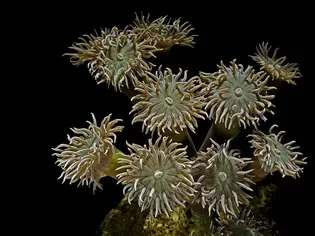How to Care for a Duncan Coral
Updated on 04/26/24

A Comprehensive Guide on Nurturing the Enchanting Duncan Coral: A Haven of Vibrant Hues and Intricate Forms in Your Aquarium
Introduction:
Immerse yourself in the captivating world of Duncan corals (Duncanopsammia axifuga), nature's exquisite masterpieces that adorn the depths of the ocean. Their vibrant hues, intricate structures, and captivating allure make them a coveted addition to any aquarium. However, to maintain their delicate beauty, it is imperative to provide them with the utmost care and attention.
Creating an Ideal Habitat:
Like meticulous gardeners tending to their prized blooms, creating an optimal habitat is fundamental for the well-being of Duncan corals.
1. Water Parameters:
- Temperature: 72-78°F (22-26°C)
- pH: 8.1-8.4
- Salinity: 35ppt
- Alkalinity: 8-12 dKH
- Calcium: 400-450 ppm
- Magnesium: 1200-1350 ppm
2. Lighting:
- Moderate to high lighting (PAR 100-200)
- A combination of blue and white LEDs is recommended
- Ensure adequate flow to prevent algae growth on the coral's surface
3. Flow:
- Moderate to strong flow
- Use a powerhead or wavemaker to create a gentle current
- Avoid direct flow from powerheads, as this can damage the coral's delicate tissue
Nutrition and Feeding:
Duncan corals thrive on a diet that mimics their natural feeding habits.
1. Phytoplankton:
- A staple food for Duncan corals
- Provide a regular supply of live or frozen phytoplankton
- Target feed the coral directly using a pipette or turkey baster
2. Zooplankton:
- A supplement to their phytoplankton diet
- Offer a variety of zooplankton, such as brine shrimp, mysis shrimp, or copepods
- Feed sparingly, as overfeeding can lead to nutrient buildup
3. Coral Food:
- Formulated specifically for corals
- Use a high-quality coral food that provides essential nutrients
- Avoid using food with artificial colors or dyes
Health and Maintenance:
Diligent monitoring and proactive care are essential for maintaining the health of Duncan corals.
1. Water Changes:
- Perform regular water changes (10-20% weekly)
- Use reverse osmosis (RO) or deionized (DI) water
- Add a marine salt mix to achieve the desired salinity
2. Pest Control:
- Inspect the coral regularly for pests, such as flatworms, nudis, or aiptasia
- Implement targeted treatment methods to eliminate pests without harming the coral
3. Fragmentation:
- Duncan corals can be fragmented to create new colonies
- Use clean, sharp tools and follow proper techniques to avoid damaging the coral
Common Issues and Solutions:
Addressing common issues promptly is crucial for the well-being of Duncan corals.
1. Tissue Receding:
- Cause: Inadequate lighting, poor water quality, or pests
- Solution: Improve lighting, perform water changes, eliminate pests
2. Brown Jelly Syndrome:
- Cause: Bacterial infection
- Solution: Quarantine the affected coral and treat with antibiotics
3. Bleaching:
- Cause: Stress from environmental factors or disease
- Solution: Identify and address the underlying cause, provide optimal conditions
Conclusion:
Caring for Duncan corals requires a delicate balance of art and science. By adhering to these guidelines, aquarium enthusiasts can provide their corals with an environment where they can thrive and display their breathtaking beauty for years to come. Remember, patience, observation, and a deep appreciation for these marine wonders are key to their long-term success.
Explore More Pets

Freshwater Aquarium Filters
How to Deal With Cloudy Aquarium Water

Saltwater Aquarium Filters
How Do You Remove Chloramines From Tap Water?

Freshwater Aquariums & Habitat
Can I Keep My Koi Fish Inside?

Saltwater Aquariums & Habitat
14 Best Floating Plants for Your Aquarium

Freshwater Fish Health
How to Treat Ich on Freshwater Fish

Saltwater Fish Health
Fin Rot in Aquarium Fish

Freshwater Aquarium Filters
How to Do Aquarium Water Changes

Saltwater Fish Health
How Do Fish Get Parasites?